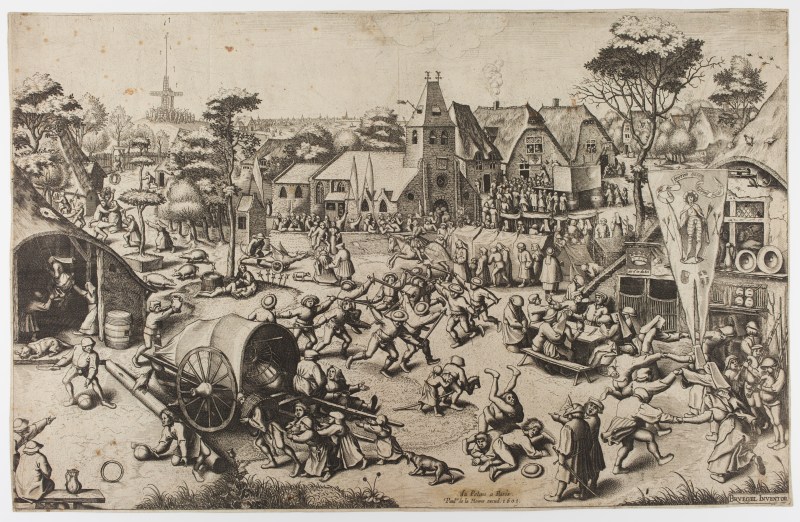Johannes and Lucas van DOETECUM: The Kermis of Saint George after Pieter BRUEGEL THE ELDER - c. 1559
Price: 32 000 €
Etching and engraving, 523 x 332 mm. New Hollstein (Pieter Bruegel the Elder) 42, 2nd state/4; Orenstein 79.
Impression of the 2nd state (of 4), Hieronymus Cock's address replaced by that of Paul de La Houve: Au Palais à Paris / Paules de la Houve excud. 1601. Before the inscription in the sky LA GRANDE FESTE DE NOSTRE VILLAGE, and other inscriptions in the plate.
Very fine impression, printed on watermarked laid paper (watermarks: bunch of grapes on one side of the sheet and vertical cartouche on the other). Very good overall condition. A small 5 x 15 mm loss of paper in the upper edge, repaired and retouched with discreet pen-and-ink lines for the clouds; small 10 mm tear at the bottom, almost invisible, two tiny 2 mm repaired holes; some foxing, mainly in the upper left corner, and three vertical folds at the top of the sheet. Small brownish traces around the inscription "Au Palais à Paris", with very discreet old ink retouching. Thread margins all around the composition.
Provenance:
- Chevalier Joseph-Guillaume-Jean Camberlyn (1783-1861), his collection mark printed on the reverse (Lugt 514). This print appears in the catalog of his sale after his death in 1865 (no. 463 of the First Part, "Très-rare et superbe épreuve ..." [Scarce and superb impression]).
- Henry d'Allemagne (1863-1950), his collection mark printed on the reverse: Mr Henry D'Allemagne 30, Rue des Mathurins, 30. PARIS, with number 49 (Lugt not described).
Paul de La Houve (c. 1575-after 1643) was a publisher and dealer in prints and paintings in Paris. "He had a store at the Palais, Galerie des Prisonniers, which Suzanne Caron [his wife, and Thomas de Leu's sister-in-law] owned from at least 1595." (Dictionnaire des éditeurs d'estampes à Paris sous l'Ancien Régime, p. 185, translated by us).
“The Kermis of Saint George is in the tradition of the numerous and often large-format prints showing peasant festivals produced by Antwerp artists in the 1550s and 1560s”. Nadine Orenstein notes that the injunction etched on the large banner "laet die boeren haer kermis houuen" [let the peasants have their festivities] echoes the last words of the legend of the Peasant Fair etched in 1559 by Pieter van der Borcht, his Antwerp rival. Bruegel differs from van der Borcht, however, by treating this traditional theme with greater subtlety. While Bruegel's view of the peasant feast seems at first glance more benevolent than that of his competitor, Nadine Orenstein draws our attention to two figures in the foreground that suggest a more critical reading: "One is a man who seems to be mocking the participants in the celebrations, as he looks out towards the viewer, exclaims to his companion and points to the scene before them. Even more telling is the presence of the fool, who walks before the cart in the foreground and is followed by several children." (Orenstein, p. 196).



